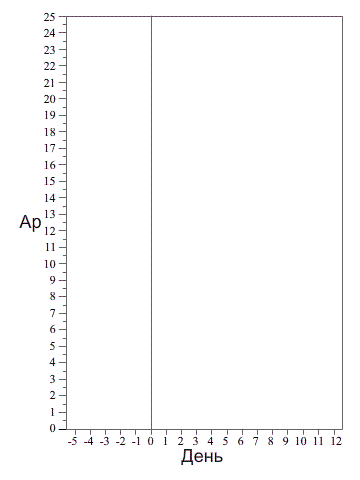Abstract of Thesis for a Master’s Degree in Computer Science
Solar activity and related geophysical parameters monitoring information support system
- coronal mass ejections, which are a consequence of active processes in solar flares and geoeffective solar emission of fibers;
- high-speed streams of solar plasma following the shock wave from solar flares and emission fibers or ejected from regions with open magnetic field configuration (coronal holes) [7] .
- Correlation method.
- The method of superposed epochs.
- Statistical processing of results.
- Interpolation functions of two variables by the method of bicubic polynomials H. Akima.
- Image function of two variables by the method of parallel sections.
 |
 |
 |
 |
| Figure 1 schedule due to the low power flash point of the passage of sunspots across the central meridian of the visible disk of the Sun |
Figure 2 schedule due to outbreaks of the average power of the moment of passage of sunspots across the central meridian of the visible disk of the Sun |
Figure 3: Graph of the relative amount of optical flares with respect to the frame of the day |
Figure 4: Graph disturbance of the geomagnetic field of the Earth (AR-index) |

1.1. Objective and scientific innovation aim of this work is the analysis and selection of methods for monitoring information, solar activity, the assessment of the impact of individual parameters on geophysical processes and the development of an application that implements the information system to support these functions for different platforms, programming. 1.2. Tasks To achieve this goal in the research process should be:
- Overview of the problem of analysis of information and methods for monitoring solar activity.
- Analysis of individual parameters on the geophysical processes.
- analysis of the properties of different programming languages and choice in terms of their properties, identification of leaders in various categories: desktop, online, mobile application.
- development programs charting the solar activity for each of the platforms on selected PLs.
- analysis methods of monitoring information in the databases of large dimension.
- design mobile application that implements a system of information support for monitoring solar activity.
- com.skychyn - the basic package, which includes classes aktiviti the main screen and the screen settings.
- com.skychyn.database - includes classes for working with databases.
- com.skychyn.webdata-charge of classes for working with sockets.
- com.skychyn.xml - contains classes to parse and analyze XML data.
- com.skychyn.draw - classes that are responsible for plotting the accumulated data.
 |
 |
 |
| Figure 6 main application screen. |
Figure 7 screen application settings. |
Figure 8: Screen construction of graphical information. |
